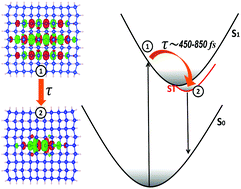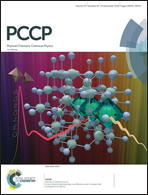Excited state dynamics study of the self-trapped exciton formation in silicon nanosheets†
Abstract
The exciton formation dynamics of several model silicon nanosheets (SiNSs) are investigated using a time-dependent density functional tight binding method. The first excited-state (S1) self-trapped exciton formation in the SiNSs is obtained by observing the frontier orbital localization related to the characteristic size of the electronic excitations. The frontier molecular orbitals are highly localized in the S1 state on the stretched Si–Si bond due to the photo-excited structural relaxation, leading to a significant Stokes shift. A time domain study of the photo-excited emission gap correlated with the frontier orbital localization properties for exciton formation. The stretched Si–Si softer bonds provide a favorable site for exciton localization, resulting in exciton trapping. The exciton formation time was found to be around ∼450–850 fs, showing the consistency of the initial exciton formation time with a recent measurement (∼500 to ∼900 fs). This study reveals that Si–Si bond breaking acts as an optical activity center and provides regulation of the self-trapped exciton formation time by the quantum confinement effect in SiNSs; significant to the Si nanomaterial properties.



 Please wait while we load your content...
Please wait while we load your content...